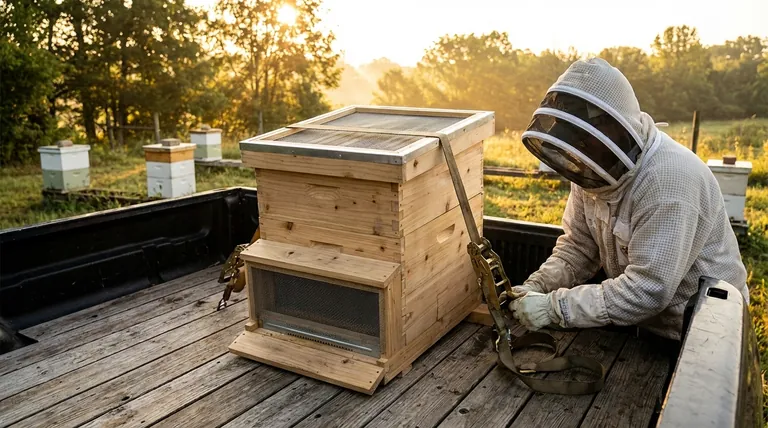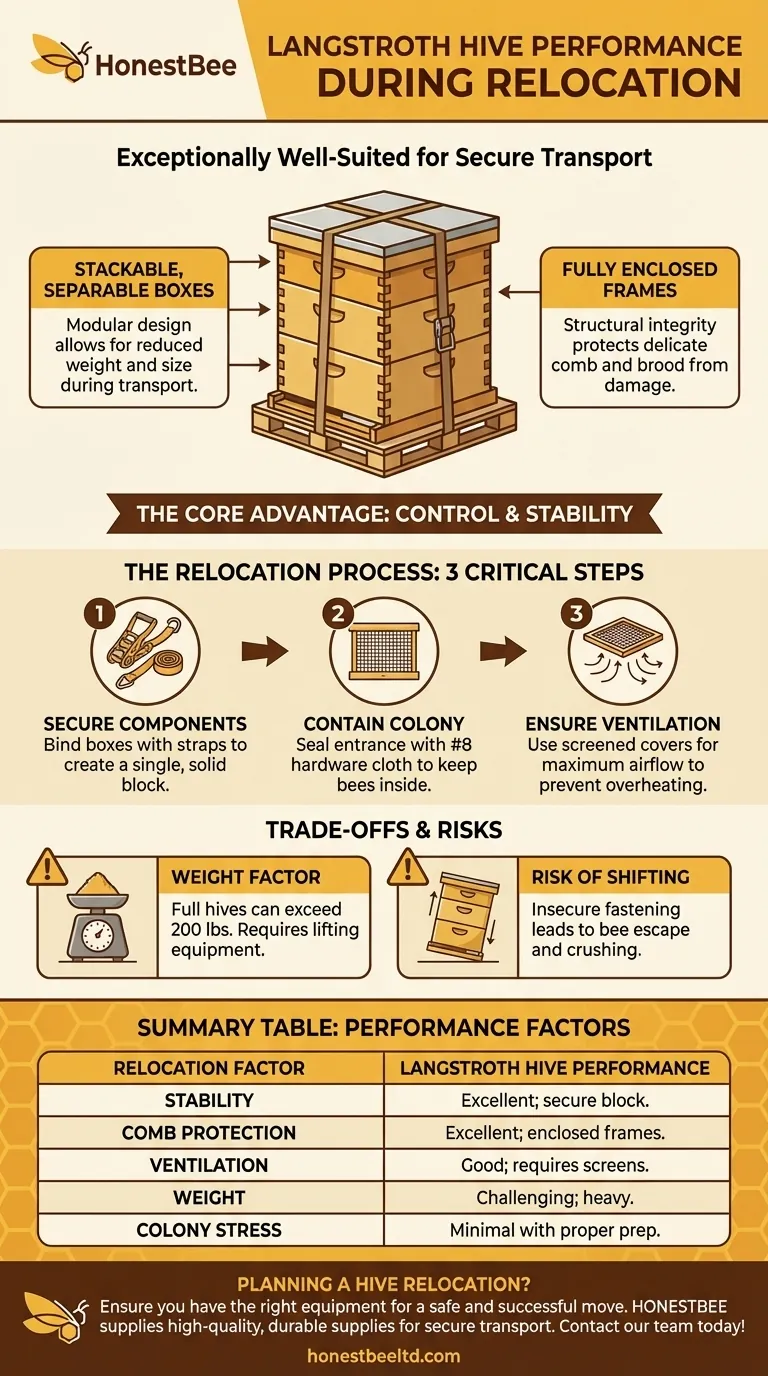In short, the Langstroth hive performs exceptionally well during relocation. Its modular design of stackable boxes and removable frames, while potentially heavy, offers significant advantages for transport. When prepared and handled correctly, this system allows for a secure move that causes minimal stress to the bee colony.
The core advantage of the Langstroth hive is control. Its components can be securely fastened together, transforming it into a stable block for transport and protecting the bees and comb inside from the shocks of movement.

The Langstroth Advantage: A Design Built for Mobility
The hive's suitability for relocation stems directly from the features that define its design, as envisioned by Reverend Lorenzo Langstroth.
Stackable, Separable Boxes
The hive is composed of individual boxes (often called "supers" or "hive bodies") stacked vertically. This modularity is a key asset for moving.
For a very large, heavy hive, you can reduce its weight and size by removing upper honey supers before the move, transporting them separately, and reassembling the hive at the new location.
Fully Enclosed Frames
Unlike hives that use simple top bars, a Langstroth hive contains full, four-sided frames. These frames hold the wax comb securely on all sides.
This structural integrity is critical during transport. It dramatically reduces the risk of delicate comb breaking loose, which could damage the brood, spill honey, and crush bees.
The Process: How to Prepare a Langstroth for Transport
A successful move is 90% preparation. The goal is to make the hive a single, solid, well-ventilated unit.
Securing the Components
This is the most critical step. The hive boxes must be fastened together to prevent any sliding or shifting during movement.
Use ratchet straps or hive staples to bind the bottom board, hive bodies, and outer cover into one solid block. This prevents bees from being crushed between the components.
Containing the Colony
The hive entrance must be sealed to keep the bees inside. This is typically done late in the evening or very early in the morning when all the foragers have returned.
A piece of #8 hardware cloth (screen) cut to fit the entrance is an ideal solution, as it contains the bees while still allowing for airflow.
Ensuring Proper Ventilation
Bees generate significant heat, and a sealed hive can quickly overheat, killing the colony. Ventilation is non-negotiable.
In addition to a screened entrance, many beekeepers use a screened moving cover in place of the standard inner and outer covers to provide maximum airflow from the top.
Understanding the Trade-offs and Risks
While well-suited for moving, the Langstroth design is not without challenges that require careful management.
The Weight Factor
A deep hive body full of honey, pollen, and brood can weigh over 80 pounds (36 kg). A multi-story hive can easily exceed 200 pounds (90 kg).
Moving a full hive is often a two-person job and may require dollies or other lifting equipment. This is a primary logistical challenge.
The Risk of Shifting
If the hive is not strapped together securely, the consequences can be catastrophic.
A box that slides during transit can create gaps for bees to escape while crushing hundreds or even thousands of others between the boxes, potentially including the queen.
Colony Stress
Any relocation is stressful for a bee colony. The move disrupts their foraging patterns and requires them to reorient to a new landscape.
However, the secure nature of a properly prepared Langstroth hive minimizes physical disturbance during the journey, which is a major factor in reducing overall colony stress.
Making the Right Choice for a Successful Move
Your approach should be dictated by the size of your hive and your primary concern for the colony's well-being.
- If your primary focus is safety and stability: Use at least two high-quality ratchet straps to bind the hive from top to bottom, ensuring zero movement between boxes.
- If your primary focus is minimizing bee stress: Move the hive at night or on a cool day and prioritize ventilation by using a screened entrance and a screened top cover.
- If you are moving a large, heavy hive: Consider removing excess honey supers to lighten the load or ensure you have the equipment and assistance needed to lift it safely.
With careful preparation, the Langstroth hive's design makes relocation a highly manageable and safe process for your colony.
Summary Table:
| Relocation Factor | Langstroth Hive Performance |
|---|---|
| Stability | Excellent; boxes can be strapped into a single, secure block. |
| Comb Protection | Excellent; enclosed frames prevent comb damage. |
| Ventilation | Good; requires screened entrances/tops for airflow. |
| Weight | Challenging; full hives are heavy and may require equipment. |
| Colony Stress | Minimal when properly prepared and moved correctly. |
Planning a hive relocation? Ensure you have the right equipment for a safe and successful move. HONESTBEE supplies commercial apiaries and beekeeping equipment distributors with the high-quality, durable supplies needed for secure transport—from ratchet straps and screened covers to durable hive bodies. Let our wholesale-focused expertise support your operation's success. Contact our team today to discuss your equipment needs!
Visual Guide

Related Products
- Langstroth Bee Hives Bee Keeping Box for Beginners Beekeeping
- HONESTBEE Professional Multi-Functional Hive Tool with Ergonomic Wood Handle
- Long Langstroth Style Horizontal Top Bar Hive for Wholesale
- HONESTBEE Advanced Ergonomic Stainless Steel Hive Tool for Beekeeping
- HONESTBEE Professional Long Handled Hive Tool with Precision Cutting Blade
People Also Ask
- What are the key features of the Langstroth beehive? A Guide to the Standard for Modern Beekeeping
- What is the best type of bee hive for beginners? Start with the Proven Langstroth Standard
- What are the different types of beehive boxes available? Choose the Right Hive for Your Apiary
- How does the ease of access differ between 8-frame and 10-frame hives? Choose the Right Hive for Your Body
- Should a beginner try a different type of hive? Start with a Langstroth for a solid foundation.



















